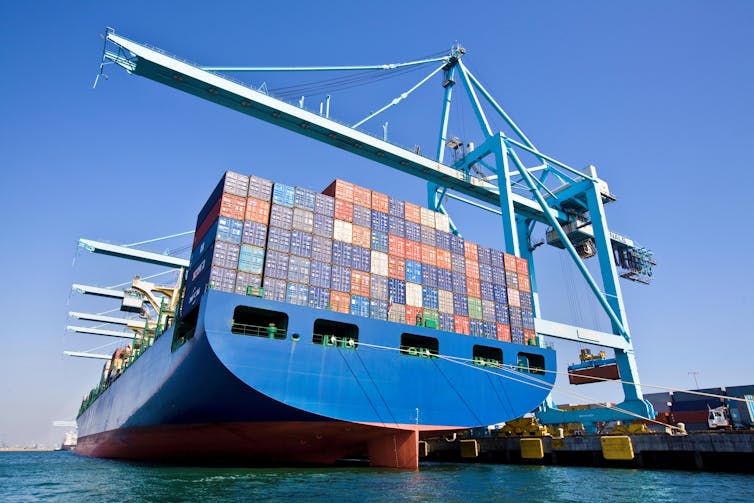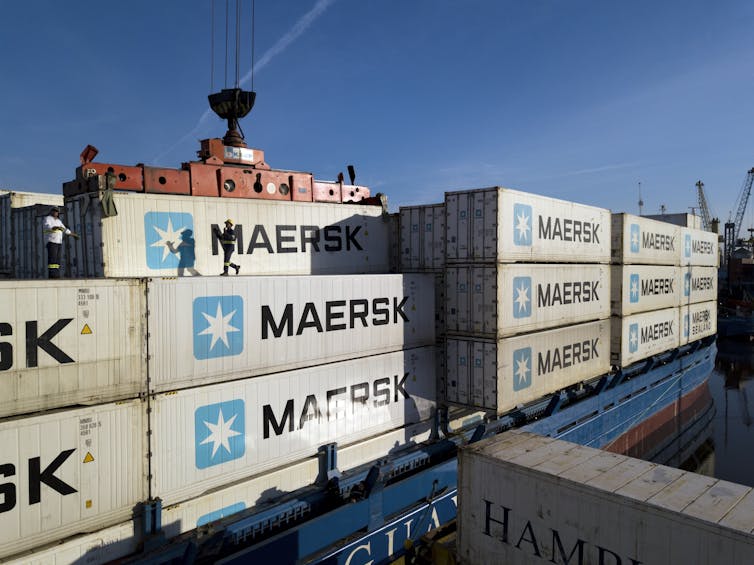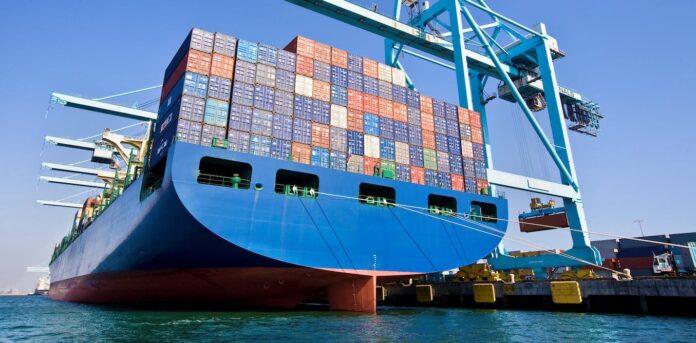Global shipping has a new climate strategy – it’s vague, obscure and almost noncommittal, but it may be pointing the industry in the right direction

By Don Maier, University of Tennessee
The world’s largest shipping companies are starting to update their fleets for a greener future. Maersk received the world’s first dual-fuel methanol container ship in July 2023, and dozens more container ships that can run on alternative fuels are currently on order.
The industry – responsible for about 3% of global greenhouse gas emissions, more than Canada and Ireland combined – has reasons to act and to have some confidence in its multimillion-dollar investments.
On July 7, the 175 member countries of the International Maritime Organization, a United Nations agency that regulates global shipping, agreed to a new climate strategy that includes reaching net-zero greenhouse gas emissions “by or around, i.e., close to, 2050.”
The strategy’s language is vague, obscure and almost noncommittal. But it points the industry toward a cleaner future. New European Union rules will also soon go into effect that will significantly raise costs for ships burning highly polluting sulfur fuel oil.
I spent several years working in the shipping industry and follow it as a researcher and analyst. Here’s what I see changing.
Setting their own direction
The new IMO strategy does not explicitly set a new fuel standard, but it seems to indicate that less reliance on cheap, environmentally harmful, heavy-sulfur fuel oil is the best direction, and possibly less use of low-sulfur fuel oil.
What the strategy does is set goals to reduce international shippings’ greenhouse gas emissions by at least 20% by 2030, compared with 2008 levels; by at least 70% by 2040; and to reach net-zero emissions around 2050. The IMO also commits to implement a greenhouse gas emissions-pricing mechanism – a carbon levy or tax – by 2027, and to develop a goal-based marine fuel standard. At this time, that’s the only direction the IMO has provided regarding the emissions-pricing mechanism.
While the new strategy may not have been as clear or restrictive as many people hoped, the IMO may be providing the maritime industry an opportunity to set the direction itself.

A number of large ship owners and operators have already built and placed orders for container ships with some sort of alternative fuel use, primarily methanol or liquefied natural gas, and there is some interest in hydrogen. LNG is still a fossil fuel, though it’s less polluting than traditional sulfur fuel oil. Methanol, however, can be made from either natural gas or renewable sources.
Maersk’s new dual-fuel vessel – to be powered in part by green methanol – is small and plans to operate in the Baltic Sea, but Maersk may be using this vessel as a prototype for larger alternative-fuel containerships expected to be delivered next year. Evergreen, also among the world’s larger shipping companies, has ordered 24 dual-fueled methanol ships.
Purchases like Maersk’s and Evergreen’s are an indication that the maritime industry will be moving in the direction of greener fuels. They also indicate that the industry is willing to follow the IMO’s focus on well-to-wake emissions, meaning not just emissions from ship operations but also from fuel production.
Building a supply chain
The other significant challenge faced by the maritime industry is having a sufficient supply chain available to support dual-fueled vessels, which can operate on alternative fuels.
There are currently a limited number of ports worldwide with the necessary infrastructure to provide alternative fuels. But, here again, simple economics suggests that if there is enough demand, supply should follow.
With Maersk, Evergreen and others preparing to operate more dual-fuel containerships, the industry is demonstrating demand so the green-methanol supply chain can develop, and hopefully soon. Japan recently launched its first dual-fueled LNG bunkering ship – essentially a floating gas station – to develop the supply of LNG fuel.
Not mandatory, but many countries will try
The new IMO strategy has some big caveats: The goals are nonbinding, and the strategy explicitly encourages compliance when “national circumstances allow.” In other words, no nation-state will be under any legal obligation to comply.
The statement seems to have been included as a means to appear focused on achieving goals while placating some countries that may not be able or willing to meet the goals by 2030 or beyond.
It’s also unclear whether the “national circumstance” pertains to a physical nation-state, to flag registry – meaning where the ship is registered – or both. Many ships are registered in countries with weaker regulations. Adding such language appears to say that the IMO is serious about emissions and understands that some countries may have significant challenges to meet the standards. It also gets around opposition to a carbon levy, or tax on emissions, which some delegates – China for example – adamantly opposed.
Many countries, such as the U.S., United Kingdom, Australia and those in the European Union, will work to meet the strategy, I believe. The EU is already launching its own carbon levy on shipping beginning in 2024.
Who pays for the higher costs?
One factor that the IMO, most analysts and environmentalists rarely discuss is the additional cost of using an alternative fuel.
By some estimates, green methanol costs three times as much as low-sulfur fuel oil. And low-sulfur fuel oil is more expensive than high-sulfur fuel oil. The maritime research company Drewry estimated that switching to methanol on a well-to-wake basis would increase fuel costs by 350%, or equal to approximately an additional $1,000 for each 40-foot-long shipping container aboard.
Shipping lines will soon also face higher costs from the European Union if they don’t clean up their emissions. Starting in 2024, the EU Emissions Trading System will cover all cargo and passenger ship voyages in EU waters and ports involving over 5,000 gross tons, regardless of where the ship is registered. The costs to those with high emissions are expected to significantly increase the operating costs for the global shipping fleet.
Hecla Emissions Management, a consulting arm set up by Wilhelmsen Ship Management and Affinity Shipping, analyzed the three-year phase-in period for just the EU change and expects it to cost the shipping industry nearly $19 billion.
Whether we like it or not, these additional costs will be born by the cargo owners, who will pass the costs along to their customers – and, ultimately, the consumer, meaning you and me.![]()
Don Maier, Associate Professor of Business, University of Tennessee
This article is republished from The Conversation under a Creative Commons license. Read the original article.



